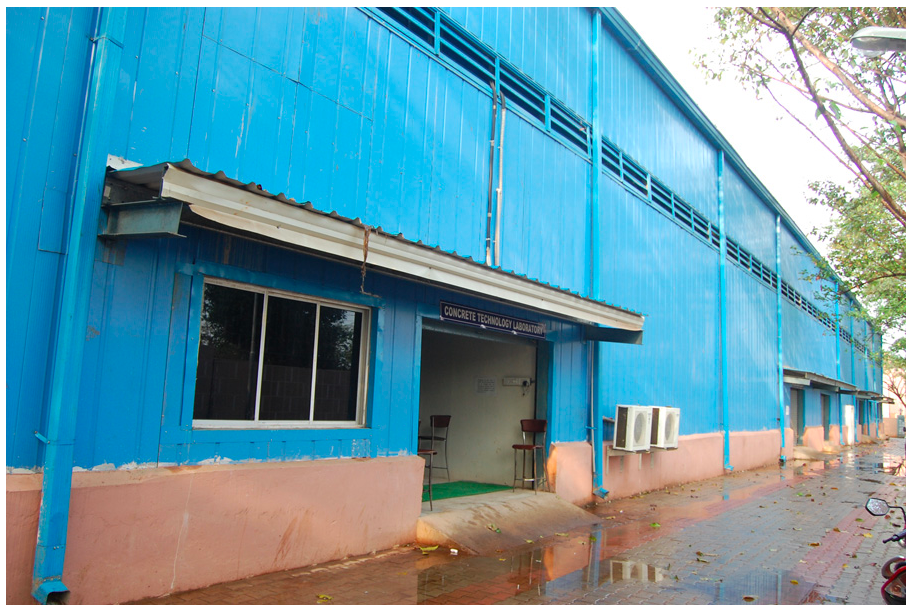Following are excerpts from the IIT Bhubaneswar convocation brochure.
Temporary Campuses
The Institute is currently operating from a number of campuses which include IIT Kharagpur Extension Centre at Samantapuri, Toshali Campus at Satyanagar and Workshop cum laboratory complex at Samantapuri. The Government of Odisha has provided us about one (1) acre of land on which we have constructed the Workshop cum Laboratory complex (3,010 sq. meters). The Government of Odisha has also made available two towers at Toshali Bhawan (10,000 sq. meters) which we have renovated. We are also getting generous support, in more ways than one, from Institute of Minerals, Metallurgical and Materials Technology (CSIR-IMMT) and Central Tool Room and Training Centre (CTTC). I sincerely thank all the members of these institutions for their continued support.
IIT Bhubaneswar is well equipped with modern class rooms and undergraduate/research laboratories. All the class rooms are fitted with multimedia projectors, internet facilities and wireless connectivity. The Institute has designed and developed three virtual class rooms (VCR) sponsored by National Knowledge Network (NKN). These virtual class-rooms are equipped with high end AV and teaching equipment and are connected to the NKN by means of a dedicated 1Gbps leased line. The VCR facilities provide real time interaction among the students and faculty members of our Institute and those from other institutions.
IITs are known for the de rigueur to have a residential campus in order to facilitate one-to-one human interaction. The Government of Odisha has provided us 14 flats at Government Colony, Gajapati Nagar. We have found cooperation from the housing society in SBI Colony Kesura (10 km from city centre) wherein we have hired 65 HIG/ MIG flats for the accommodation of our students, few of our staff and faculty members. Another hostel at Madanpur (15 km from the city centre) has been provided for M. Tech. students and Ph. D. scholars. In addition, IIT Kharagpur has constructed a new 200 capacity Dr. A. N. Khosla Hall of Residence at Samantapuri for the students of this Institute. I take this opportunity to thank IIT Kharagpur for constructing the hostel which is of great convenience to us. I would also like to put on record my deep appreciation to the students, the staff and faculty members who have to commute regularly between their residence and the various academic campuses. I am aware that this is strenuous. But I am hopeful that our students, faculty and staff members would bear it and be a part of the history in the making.
Permanent Campus
The Foundation Stone of the permanent campus at Arugul (near Jatni) was laid on 12th February 2009. The Government of Odisha allotted 936 acres of land at Arugul for developing this IIT of which the Institute has already taken possession of 598 acres. The Government of Odisha has started construction of a 4-lane access road to the campus from the National Highway No. 5. The work on water and electric supplies to the campus is also in progress. The Government of Odisha has also agreed to provide 75 acres of land on the Puri–Konark coast line to set up an Innovation Centre for Climate Change for the School of Earth, Ocean and Climate Sciences.
Out of 19 km, construction of 13 km of boundary wall has been completed. More than 10 bore wells have been sunk to facilitate construction work. The Institute has also taken up tree plantation programme for its new campus.
The master plan of the new campus at Arugul has been approved for 10,000 students, 1000 faculty and 1100 supporting staff and the total construction should be completed in 3-phases in next 12-15 years. The Ground Breaking Ceremony was organized on 14th August 2011. The work for land grading, road and other related construction have started. The Government of India has approved construction of 221,000 sq. meters of covered area in the 1st phase. Our consultant has completed the designing of 130,000 sq. meters of covered areas for various Schools, residential quarters, hostels and other service/administrative buildings for construction based on the availability of fund in the initial phase. Clearances for construction from various statutory bodies have been obtained. The tendering process for part of the construction is over and I am very happy to announce that CPWD has just started the construction of the hostel complex. Our consultant and CPWD are also ready for tendering for the remaining part of construction. The Institute plans to move to its permanent campus by the beginning of 2014.
Academics
Academic Schools We began our journey with a mission to promote a borderless academic environment with the concept of Schools, rather than Departments to enable and encourage the academic staff and students to work in an interdisciplinary environment. Initially the following five (5) schools were set up:
â— School of Basic Sciences (Bioscience, Chemistry, Mathematics, Physics)
â— School of Electrical Sciences (Computer Science and Engineering, Electrical Engineering, Electronics & Communication Engineering, Energy, Instrumentation, Learning Sciences)
â— School of Humanities, Social Sciences and Management (Economics, English, Management, Psychology)
â— School of Infrastructure (Architecture, Civil Engineering, Town Planning, Traffic & Transportation Engineering Urban Design)
â— School of Mechanical Sciences (Aerospace Engineering, Manufacturing & Industrial Engineering, Mechanical Engineering, Naval Architecture)
The state of Odisha and neighborhood including the vast coastline is rich in mineral resources and biodiversity. The region is also adversely affected by flood, cyclone and other natural calamities. In view of this, the Institute has set up the following two (2) Schools:
â— School of Earth, Ocean and Climate Sciences
â— School of Mineral, Metallurgical and Materials Engineering
The Institute is also setting up an Innovation Centre for Climate Change on the Puri-Konark coast line. The following Schools are proposed to be set up in the second phase of expansion:
â— School of Chemical and Biochemical Engineering (Biochemical, Biomedical and Chemical)
â— School of Design and Creative Arts
Academic Activities
The Institute started its journey in 2008 with a total of 94 students in three (3) undergraduate programmes viz. Civil, Electrical and Mechanical Engineering, with an intake of 40 students in each programme. The Institute has introduced Ph. D. programme from 2009. From July 2012 we have started postgraduate (Joint M. Tech. – Ph. D.) programmes in Electronics & Communication Engineering, Civil Engineering, Mechanical Engineering, Climate Science & Technology, Applied Geoscience and Materials Science & Engineering. The Institute is going to start Joint M. Sc. – Ph. D. program in Chemistry, Earth Science, Physics and Mathematics from the next academic session.
Currently the Institute has 571 students (B. Tech. 456; Preparatory 2; M. Tech. 41; Ph. D. 72), 70 full-time faculty members, 1 Chair Professor, 6 officers and 40 supporting staff.
It is heartening to note that the pioneer batch of undergraduate students who are receiving their degree today are all placed. Many of the students have received offer of admission/scholarships from prestigious universities abroad: Stanford University, University of Illinois at Urbana Champaign, Cornel University, Ohio State University, Pennsylvania State University, University of Texas, Imperial College of London to name a few.
Research & Development
Activities: In-house, Sponsored, Consultancy Our faculty members, research scholars and undergraduate students have been actively pursuing research in varying areas. The Institute has received a number of sponsored projects from various funding agencies like DST, CSIR, DBT and DRDO and consultancy from industries worth more than Rupees 480 lakhs. The faculty members are also engaged in various consultancy activities. Project proposals worth more than Rupees 700 lakhs have been submitted.
IIT Bhubaneswar has been successful in its bid for the following UK-India Education and Research Initiative (UKIERI) projects:
Joint Masters and Split-Site Ph. D. Programme: An Integrated Doctoral and Masters Programme with the University of Warwick – To develop an integrated suite of postgraduate joint degree programmes.
Thematic Partnerships Programme 1: UKIERI Thematic Partnership in Low Carbon Materials Technologies, Innovation and Application jointly with the University of Warwick – To enable the rapid and effective introduction of new steel and multi-material combinations, for new applications addressing the global imperative of carbon reduction.
Thematic Partnerships Programme 2: UKIERI Thematic Partnership jointly with the University of Southampton and National Oceanography Centre and University of Massachusetts at Dartmouth – To establish the School of Earth, Ocean and Climate Sciences at the Indian Institute of Technology Bhubaneswar and Marine Campus on the Bay of Bengal.
I would like to highlight in brief the ongoing R&D activities in various Schools:
The School of Basic Sciences is a cluster of disciplines namely Bioscience, Chemistry, Mathematics and Physics. The School is carrying out research in the areas of multimetallic catalysis, organometallic chemistry, supramolecular chemistry, coordination chemistry, synthesis of natural products and intermediates. The research work in biosciences is focused on understanding the structure and function of various proteins of eye lenses, leprosy, and tuberculosis. The research in high energy physics is focused on understanding fundamental particles and their interaction using theoretical tools such as string theory, and experimental setup in collaboration with CERN, Geneva. Specific areas include conformed field theory, pure spinor formalism of superstrings, super symmetry and black holes. A number of projects have been undertaken in the area of the plasmonics, photonics, ion-surface interactions, design and development of sensors, magnetic grids, energy storage devices and optoelectronic devices. Multidisciplinary work is underway in the area of nanomaterial-based device design, assembling and clustering. On-going research in mathematics includes complex dynamics and fractals, variational inequalities and complementary problems, queuing theory, mechanics, computational fluid dynamics, algebraic graph theory, neural network and artificial intelligence.
The major R & D activities of the School of Earth, Ocean and Climate Sciences includes monitoring, prediction and providing mitigation solutions for natural disasters with sound and precise observational network of meteorological, oceanographic, geological and geophysical instruments combined with data-assimilative modeling in a multi-institutional framework and use of Information and Communication Technology (ICT), thereby becoming a hub of such activities on the east coast of India with an international presence. The thrust areas are: Climate Modeling, Modeling of extreme events, Cloud Physics, Numerical Weather Prediction, Natural Resources-exploration and utilization, Climate Change and its Effects, Biological Oceanography, Application of the Space Technology for the Study of the Earth System Science, Soil Water Interactions, Waste Utilization, and Pollutant Pathways.
The research activities in the School of Electrical Sciences includes the following: Antenna Design, Smart Antenna Techniques for MIMO Systems, Radio Frequency Identification System Design & Application, Non-Destructive Testing Methods, Digital Signal Processing, Speech & Real Time Interactive-Audio Processing, Active Noise Control, Cognitive Radio, Sensor Networks, Intelligent Instrumentation, OptoElectronic Devices, Long-haul Optical Communication System Design, Optical Sensor, Communication & Wireless Communication System Modeling & Design, Semiconductor Material & Device Characterization, Wide Band Gap Semiconductor Devices, MMICS, Decoupling & Robust Control, Periodic Feedback Control, Power Quality Analysis, Custom Power Devices, Renewable Energy Sources, Application of SoftComputing Techniques to Power Systems, Intelligent Protection to Transmission Systems-Facts, Micro & Smart Grids, Distributed Generation & Dynamic Security Assessment in Large Power Network, Structural Health, Integrity Analysis & Monitoring (SHIM).
The School of Humanities, Social Science & Management is pursuing research in the areas of Environmental Economics, Natural Resources Economics, Macroeconomics, Development, Economics & Rural Development, Indian Writing in English, Post-Colonial Literature, Travel Writing, Business Communication, American Literature, Canadian Literature, ELT, Cross Cultural Communication, Autobiography, Consumer Behaviour, Cyber Psychology, Clinical Psychology, Cognitive Psychology, Cognitive Neuroscience, Psycholinguistics, Psychology of Personality, Marketing.
The present research in the School of Infrastructure are in the thrust areas of Concrete Technology, Earthquake Engineering, Traffic Flow Modeling, Travel Demand Modeling, Travel Behaviour Analysis, Transportation System Planning & Policy Address, Energy Geotechnology, Soil-Structure Interaction, Fluvial Hydraulics, Waste Water Engineering, Water Resources Engineering, Study of Unsaturated Soils Behavior.
The School of Mineral, Metallurgical and Materials Engineering is actively pursuing research in the areas of Solidification Processing, Metal Matrix Composites, Ti-Based Alloy, Automotive Applications, In-situ Metal Matrix Composites, Semi-solid Processing, StructureProperty-Processing Correlations in Metals, High Cycle Fatigue and Fracture in Metals, Friction Stir Welding/Processing, Modeling & Simulation, Structural & Magnetic Frustration of Materials, Synchrotron and Neutron diffraction, 3-D Atom probe (LEAP), Metallic Glasses, Process Modeling & Study of Diffusion in Solids.
The School of Mechanical Sciences conducts R&D activities in the following areas: Computer-Aided Design & Manufacturing, Robotics & Controls, IC Engines, Multi-Phase Flow, Computational Fluid Dynamics, Conjugate Heat Transfer, High Reynolds Number Turbulence, Optical Flow Diagnostics, Turbulence Modeling & Simulation and Acoustics, Composite Materials, Sandwich Structures, Fracture Mechanics, Material Science, Green Supply Chain Management.
Publications
Within 3 years of existence in the city of Bhubaneswar, the faculty members and students have contributed to creating new knowledge by publishing 230 original research papers in National and International Journals of repute, and 20 books/book-chapters. Besides, 128 papers have been presented in various National and International Conferences in India and abroad. Our undergraduate students have also made technical presentations in conferences, nationally and internationally.
Endowment
Industries have come forward to join us in developing this new IIT. The MGM Minerals Group has established a perpetual “MGM Chair Professorship” in the School of Minerals, Metallurgical and Materials Engineering with an endowment of Rs 300 lakhs. In addition the MGM Minerals Group has instituted two awards for best B. Tech. theses (Electrical and Mechanical Engineering) in memory of Tejaswi and Dinesh, two budding students of our Institute, whom we lost in a tragic train accident in March 2011.
October 10th, 2012
[**UPDATE: Official AIIMS Bhubaneswar web page is now at http://aiimsbhubaneswar.org/ and a new one will come up at http://aiimsbhubaneswar.edu.in. **]
We have collected some information on AIIMS Bhubaneswar below. Hope it is useful to the 2012-13 batch of selected students and faculty. Latest information is at this facebook album.
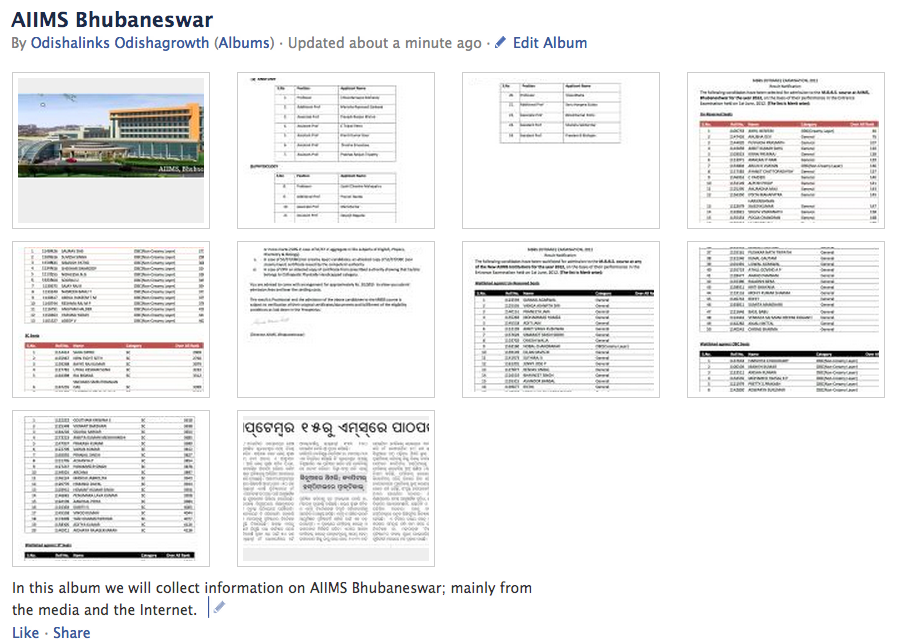
Prof. A.K. Mahapatra (Currently Professor & Head of the Dept. Of Neurosurgery at the
Neurosciences Centre, AIIMS, NEW DELHI-11029) has been selected as the founding director of AIIMS Bhubaneswar. He is waiting for his release from AIIMS New Delhi to formally take on his new position. His contact details are mentioned in his CV.
[Update on 16th August 2012: From today’s news it seems Prof. Mahapatra has formally taken charge of the Director’s position and has taken some immediate actions.]
Earlier news on AIIMS Bhubaneswar are categorized here or here. A few years back we compiled some information on Odisha and Bhubaneswar which may come in handy.
If anyone has any related questions please put a comment and we will try to answer. But first, please explore the above mentioned links. One may also explore the links in the right hand side of this page and the facebook page https://www.facebook.com/odishagrowth.
July 31st, 2012
As per this Business Standard article out of 35 students that graduated from NISER Bhubaneswar this year 11 are going abroad for Ph.D (to places such as Stanford, Carnegie Mellon, Pennsylvania, Chicago, Stony Brook), 5 are going to TIFR for PhD, 2 are going to IISc Bangalore, 4 to NII Delhi and 4 to various IITs. This adds up to 26.
Even when a lot of IIT students were going abroad, no department of any IIT was sending so many to pursue Ph.D.
Kudos to NISER to live up to the dreams and goals behind establishing the IISERs and NISER.
Finally, considering the angst of some of the alumni of the IISERs (especially IISER Pune) kudos to NISER for holding its own entrance exam (and not take students from IIT JEE) so that students who come into NISER are more in synch with the institution in terms of their expectation. (Update: Just to be clear, now, IIT JEE is only one of the three means to get admitted to IISERS. The other two are via KVPY and an aptitude test.)
June 27th, 2012
The following is an excerpt from http://ibnlive.in.com/news/coming-up-innovation-centre-for-climate-change/251002-60-117.html.
India will very soon have the first-ever Innovation Centre for Climate Change (ICCC) to cover the Bay of Bengal. It will come up on the Konark-Puri road. The Centre will function under the Indian Institute of Technology, Bhubaneswar (IITB).
The Bay of Bengal Coastal Observatory (BOBCO) as it has been named will study the behaviour of the Bay of Bengal. With the completion of the observatory, the country will be able to forecast extreme weather conditions and collect data about the ocean behaviour and numerous other details like the physical, chemical, biological and Geo-scientific data. “All this information will be instrumental in preparing a model for understanding cyclone. We would have understood the 1999 cyclone better if we had this observatory back then,” said Earth, Ocean and Climate Sciences Prof Prem Chand Pandey.
Its working will be different from the Meteorological Department (MET) as the ICCC will look into the causes behind the occurrences in the ocean while MET department records the ocean behaviour and gives continuous information.
The ICCC will come up along with the School of Earth, Ocean and Climate Science (SEOCS) under IITB. The SEOCS, which will come up at Arugul, will be headed by Prof Subhashish Tripathy. The State Government had allotted around 936 acre land for the construction of the SEOCS. It also recently allotted around 75 acres for setting up of the observatory.
… For the setting up of the observatory, IITB is working closely with University of Massachusetts and University of South Hampton. They will also conduct the Ocean Instrumentation Training Programme to train people with the advanced instruments that will be used in the ICCC. “There will be around 12 faculties initially, but with the gradual growth of the school, more and more experienced faculties will be brought in,” said Tripathy. The recruitment process has already begun. The institute also has ambitious plans to conduct research in the field of land, ocean and atmosphere, added Pandey.
April 23rd, 2012
Following is rearranged from http://pib.nic.in/newsite/erelease.aspx?relid=82396. The sub-headings are added by me.
On 14 Innovation Universities
Recognizing the need for leveraging on the creative knowledge, we are also planning to set up 14 Innovation Universities, to begin with, aiming at world class standards which will set benchmarks for excellence for the Central and State Universities. Each of the Innovation University shall consistently aspire for attainment of pinnacle of knowledge and will provide the knowledge manpower of the country in training professionals, specialists, scientists and researchers needed by the supporting national innovation system. Government has already framed a legislation for Universities of Research and Innovation which will provide a facilitating framework for creation of these institutions. These universities would be embedded in ecosystems developed for promoting synergies among education, research and incubation centres or industry
In order to be truly innovative, these Innovation Universities will not be clones of each other, but will focus on one deep theme of innovation and will focus on one area or problem of global significance in general and India in particular, by building an ecosystem of research and teaching around related discipline and fields and will search for solutions that are globally valid. For example, such areas may focus on urbanization public health, water security, environmental sustainability, digital literacy etc. The proposed universities will be autonomous in true sense, designing their own knowledge disciplines, admission criteria, academic programmes, credit systems etc. The programmes shall also facilitate horizontal mobility across disciplines.
…
We have realized that traditional models of public funded universities are not enough as the investment required is too high. We do acknowledge the need for policies to encourage private investment in higher education and the Foreign Education Providers’ Bill, now under consideration of the Parliament, is a decisive step in that direction. Although Government will be prime facilitator of the new innovation universities and innovation clusters, it is also proposed to focus on Public Private Partnerships (PPP) mode. It is also proposed to collaborate with Universities elsewhere in the world and they may be invited to set up similar such institutions in India and Government will support its research and establishment needs and teaching including scholarships may be funded by the promoting university. New Greenfield Innovation Universities supporting an already existing University/Institution of repute to attain world class standards through innovation in chosen areas of knowledge as well as Identification of some educational hubs in the country, where a few institutions of excellence are located and create an architecture of Innovation University by promoting synergy for teaching and research among such institutions are the models that we are aiming at promoting.
Cluster Innovation Centers
We have also planned creation of Cluster Innovation Centres in our Higher Education Institutions for promoting linkages for innovations, and R&D for solving the real problems and creation of products and processes for which systemic reforms have already been initiated for facilitating the linkages with industry and society. The Cluster Innovation Centres will provide a platform for the University and its partners to forge linkages between various stakeholders from industry and academia and to act as catalysts and facilitators. We have prepared a blueprint for setting up about 50 innovation centres of excellence in different frontier areas. Cambridge Cluster in UK as well as Trinity College founded by Cambridge Science Park are two prominent examples from UK which have promoted the growth of enterprise and innovation and created thriving innovation ecosystems. Such examples also exists in US (MIT, Silicon Valley – Stanford University), Israel, Germany, Sweden, Japan, China and Korea. Biggest strength of these clusters has been the cooperation and collaboration, where all actors are connected in symbiotic relationships. We are also aiming to scale up such National Innovation Clusters. We already have a few such schemes in the form of Technology Business Incubators and Technology Entrepreneur Promotion.
Collaboration with UK
The Cluster Innovation Centers and Innovation Universities are the specific areas in which we seek further collaboration with UK Institutions who have already innovated and scaled up by creating appropriate framework and institutionalized the same successfully.
Meta Universities
Seizing the new opportunities and leveraging the National Knowledge Network, the National Innovation Council has also proposed to create the first Global Meta University. With a network of Universities coming together offering courses cutting across disciplines, the Meta University will reinterpret the concept of a University as not just a traditional, physical space of learning, but as a repository of knowledge and information that can be delivered in multiple ways, and can be accessed from anywhere and anytime. It will seek to enhance the learning experience through new and innovative delivery models of education that allow students and institutions to collaborate in unprecedented ways. Thus the 21st century meta-university would be a network and an ecosystem rather than a single brick and mortar space – a Facebook of Institutions. A few central institutions located at Delhi, like Jawaharlal Nehru University, University of Delhi, Jamia-Millia Islamia and IIT-Delhi have already initiated steps to constitute a meta-university. Here also, we are looking forward to collaborate with Institutions from the United Kingdom in the next step for creation of global meta alliances. Though the internet and technology are fundamental to this conception of the Meta University, at the crux is not a new technology but a ‘new pedagogy’ that is more in tune with the requirements of the knowledge society of the 21st century. In such an environment there is a greater focus on a learner centric, collaborative model that allows continuous learning from the environment.
April 20th, 2012
So far IIT Bhubaneswar only offered B.Tech and Ph.D programs. It has now advertised its new M.Tech programs which are actually joint M.Tech-Ph.D programs that allow one with GPA greater than 8 (after doing the M.Tech coursework) to seamlessly transition to a Ph.D program or just get an M.Tech degree. The details of the program is given at http://www.iitbbs.ac.in/applicationforms/advt/Information-for-Admission-to-Joint-M.Tech.-Ph.D.Programme.pdf.
Following are some excerpts from that.
INDIAN INSTITUTE OF TECHNOLOGY BHUBANESWAR
INFORMATION FOR JOINT M. TECH. – PH.D. PROGRAMME Joint M. Tech. – Ph. D. Programme in:
* Applied Geosciences
* Civil Engineering
* Climate Science & Technology
* Electronics & Communication Engineering
* Materials Science and Engineering
* Mechanical Engineering
Selection: Valid GATE score followed by Written Test and/or Interview. Opting for Ph. D. Programme:
Desirous students with CGPA greater than equal to 8 after the 3rd semester of the M. Tech. programme with an aptitude towards research can opt for Ph. D. Those students with CGPA less than 8 will exit with M. Tech. degree after successfully completing the fourth semester and the credit requirements.
… Number of Seats: 18 in each programme. (Reservation as per GOI norms applicable).
In addition to the above mentioned joint M.Tech/Ph.D program IIT Bhubaneswar has also advertised for direct admission to its Ph.D programs in each of its seven schools .
See http://www.iitbbs.ac.in/applicationforms/advt/Information-for-Admission-to-Ph.D.Programme.pdf for details.
With these programs added and currently with only 120 B.Tech students admitted per year, IIT Bhubaneswar will have more graduate students (M.Tech and Ph.D) admitted per year than undergraduate students (B.Tech). This is a good direction and IIT Bhubaneswar should strive to have more graduate students than undergraduate students thus putting emphasis on research.
April 14th, 2012
The ad is at http://www.aiimsexams.org/pdf/ADMISSION-NOTICE-MBBS-2012.pdf. The prospectus is at http://www.aiimsexams.org/pdf/MBBS_Prospectus_2012.pdf. Following is the admission notice.
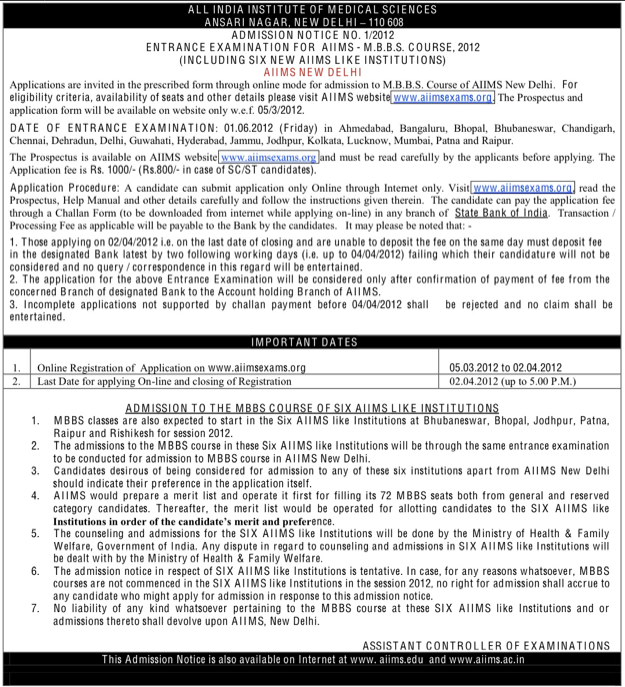
Following are excerpts from the prospectus.
Other AIIMS like Institutes Under the Pradhan Mantri Swasthya Suraksha Yojana
6 New All India Institutes of Medical Sciences are being established similar to AIIMS, New Delhi. Government of India has decided that the Academic Session in six New AIIMS at Bhopal, Patna, Jodhpur, Rishikesh, Raipur and Bhubaneswar starts in August 2012. The proposal is for an intake of 50 students for each of the institutions. The Ministry after deliberation took the view that for the first academic session (2012-2013), selection for admission should be done through the same entrance examination through which candidates are selected for AIIMS New Delhi. The counselling and admission in Six New AIIMS will be done by the Ministry of Health & Family Welfare, Government of India. Any dispute in regard to counseling and admission to six new AIIMS will be dealt with by Ministry of Health and Family Welfare, Nirman Bhavan, New Delhi.
1:0 NUMBER OF SEATS & RESERVATION
AIIMS NEW DELHI
A. Each year 77 (seventy seven) seats are available for admission to the graduate medical course, leading to the award of the degree of M.B.B.S. by the All India Institute of Medical Sciences,Delhi. Out of these, 11 (eleven) seats are reserved for the Scheduled Castes, 5 (five) seats are reserved for the Scheduled Tribes, 19 (nineteen) seats are reserved for Other Backward Classes and 5 (five) seats are reserved for the Foreign Nationals nominated by the Government of India and 37 (thirty seven) seats for General Category. For Indian Nationals, 3% reservation for orthopaedic physically handicapped shall be provided on horizontal basis, in the seats available. If requisite number of suitable candidates are not available to fill the seats reserved for the Scheduled Castes, the same are filled out of the candidates belonging to the Scheduled Tribes and vice versa. In case suitable candidates are not available from the above two reserved categories, Orthopaedically handicapped and OBCs, the vacant seats will be filled by the candidates from the general category.
SIX AIIMS LIKE INSTITUTIONS
B. From August 2012, Six New AIIMS like Institutions (viz: Bhopal, Patna, Jodhpur, Rishikesh, Raipur and Bhubaneswar) will start with an intake of 50 students each. The reservation policy followed will be 7.5% ST, 15% SC and 27% OBC. For Indian Nationals, 3% reservation for Orthopaedic physically handicapped shall be provided on horizontal basis, in the seats available.
… The candidate is required to go through the prospectus carefully and acquaint himself/herself with all requirements with regard to filling in of the online application form. Candidates are advised to give order of preference for the Six New AIIMS, apart from AIIMS New Delhi in the Application Form.
… For enquiries relating to Counseling and Admission to Six new AIIMS,please contact from 1st July, 2012 onwards:
PMSSY Section, Room No.22 ‘A’ Wing, Ministry of Health and Family Welfare, Nirman Bhawan , Maulana Azad Road, New Delhi-110 011 Tel Fax: No- 011-2306187, Website: www.mohfw.nic.in & Email : admissionpmssy@gmail.com
March 3rd, 2012
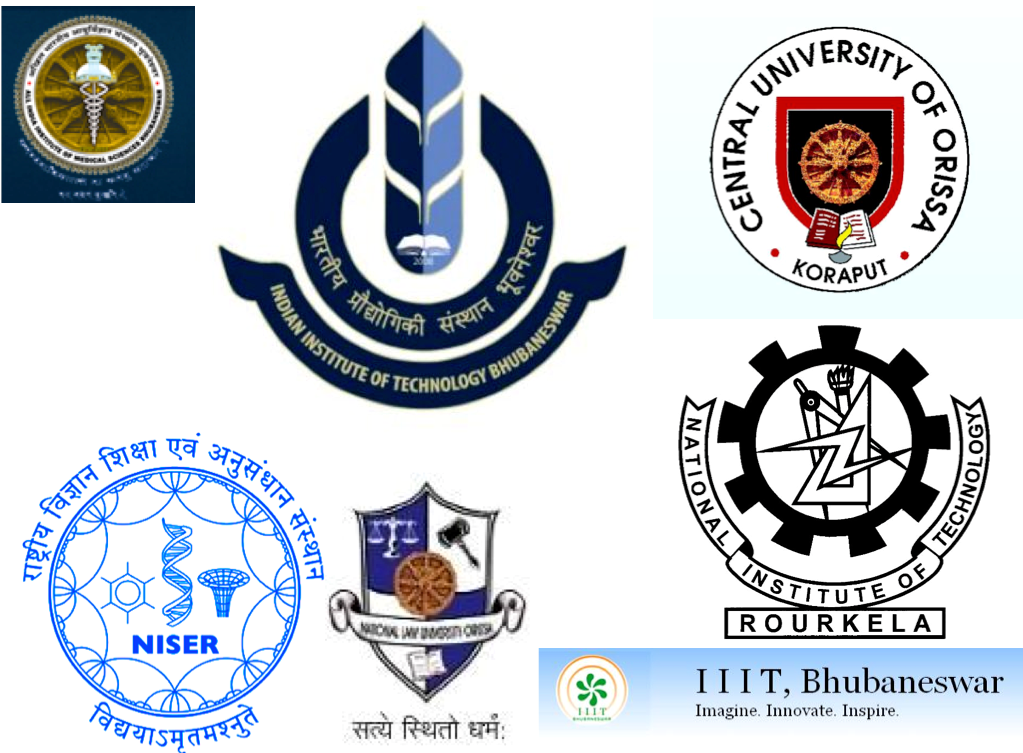
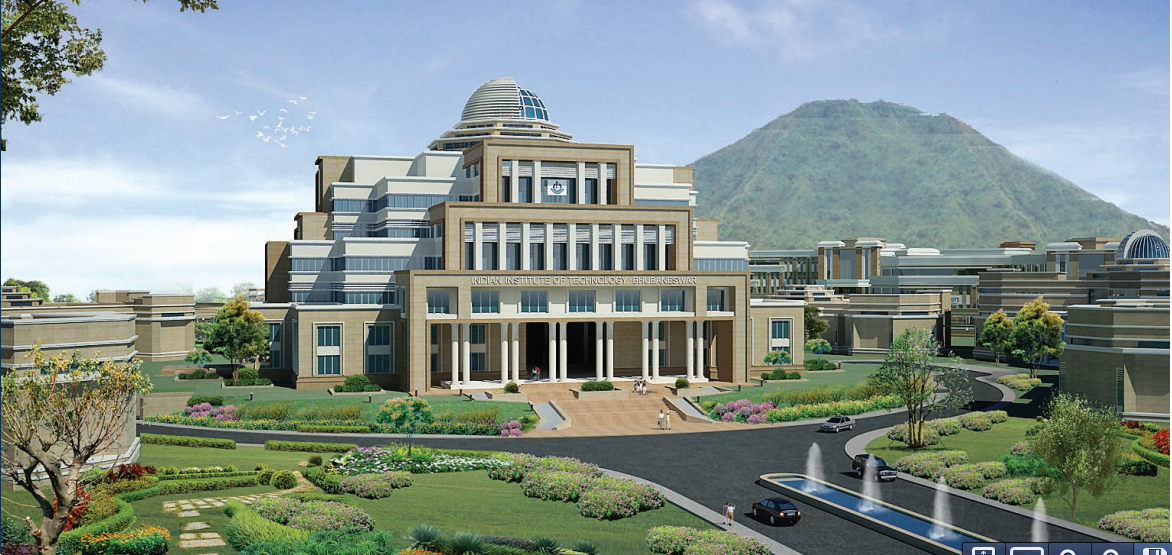


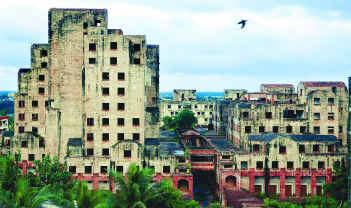 Now it looks as follows. (Obtained
Now it looks as follows. (Obtained 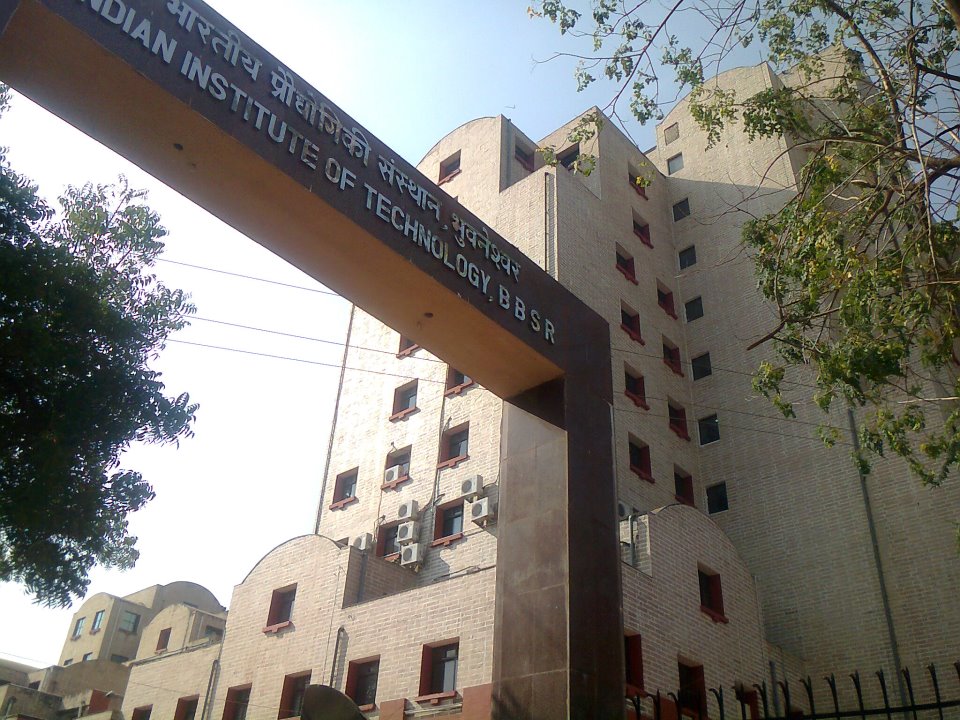
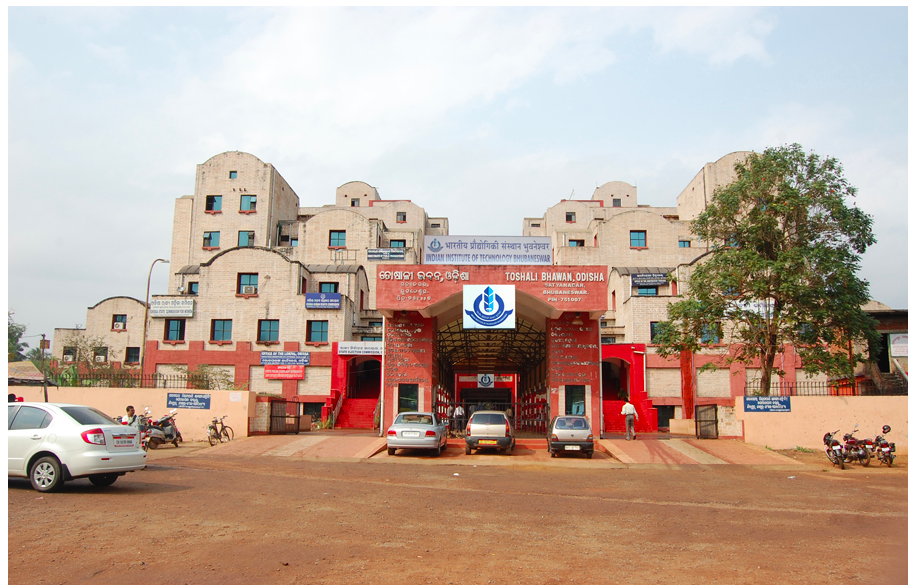 While its main campus gets built IIT Bhubaneswar has built some new facilities in its Samantapuri campus. Following is how one of the new facilities (a hostel) look. (
While its main campus gets built IIT Bhubaneswar has built some new facilities in its Samantapuri campus. Following is how one of the new facilities (a hostel) look. (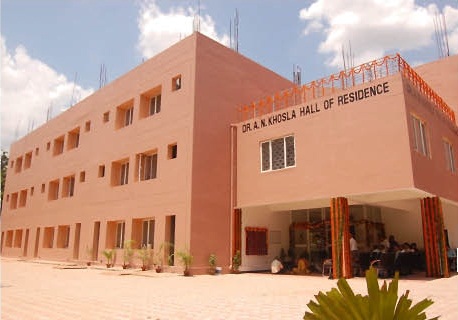
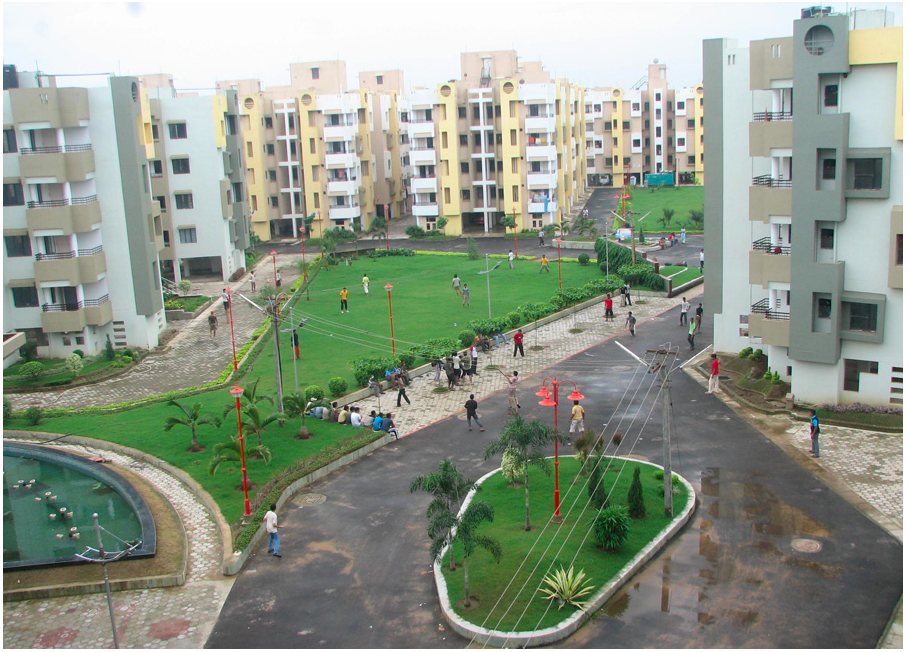
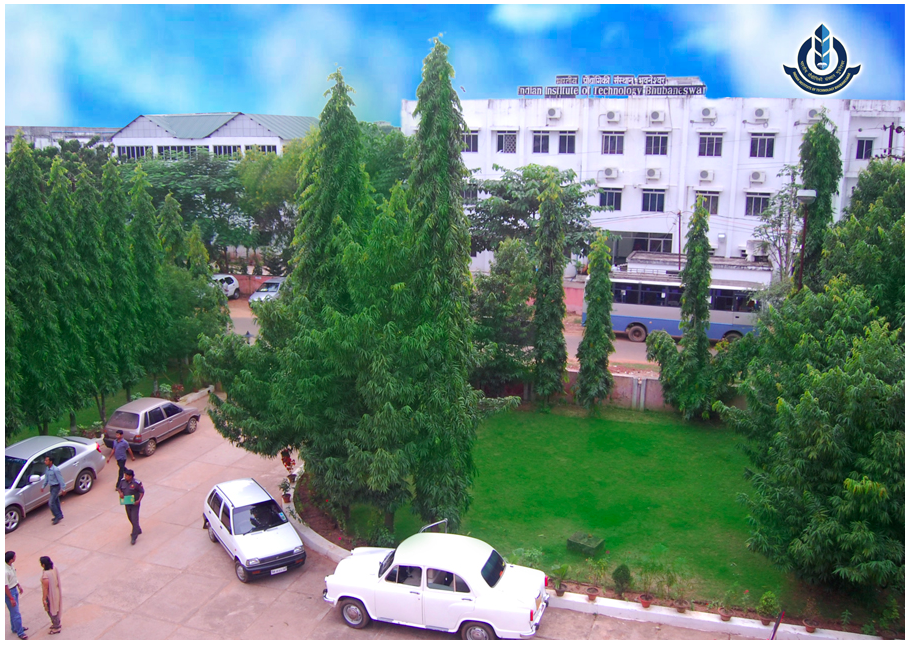 Workshop Building
Workshop Building